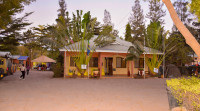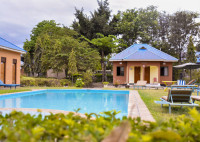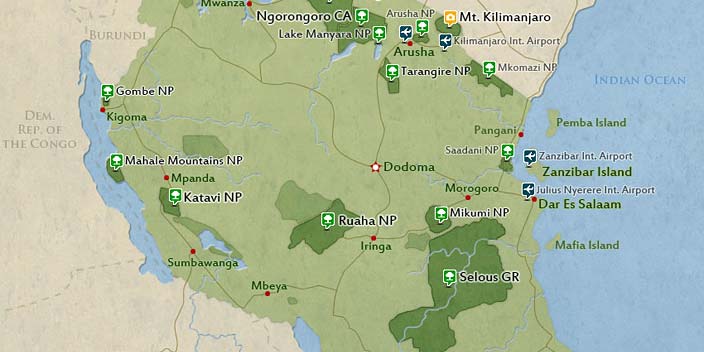
Arrival
Arrival

Day 1
Arusha to Tarangire National Park
Arusha to Tarangire National Park
Your safari guide will pick you up in the morning from your Arusha lodging. The Maasai grasslands, dotted with acacia trees, are gently undulating as you drive on a decent tarmac road. Many Maasais in their vibrant clothing will be seen along the way as they ride bicycles, walk along the side of the road, herd cattle, and push donkey carts.
Tarangire is renowned for its sizable herds of elephants. Experience the Tarangire River, savannah, and seasonal marshes from the vehicle's open roof. Look for a variety of creatures, such as giraffes, buffalos, elephants, zebras, and wildebeest. You might catch a glimpse of lions pursuing their prey or of leopards lounging in the branches above. You will depart the park and make your way to a nearby campground following a lengthy game drive during which you will have taken in all the sights and sounds of the wild. With hordes of monkeys scuttling among the treetops, the camp is ideally located for dinner and an overnight stay.
- Main Destination:
- Tarangire National Park
- Accommodation:
- Fanaka Lodge
- Meals & Drinks:

Day 2
Tarangire National Park to Serengeti National Park
Tarangire National Park to Serengeti National Park
Following breakfast, you will head into the lush highlands where the Iraqi people cultivate corn, wheat, and coffee. Traveling through the Ngorongoro Conservation Area, a crater of breathtaking grandeur formed by a volcano eruption some three million years ago. Before continuing to the Serengeti National Park, you will get the opportunity to witness the amazing emptiness of the Ngorongoro caldera. You will arrive at Serengeti, which means "Endless Plain" in Maa, the Maasai language, around midday. The largest park in Tanzania is the Serengeti National Park, which features a variety of environments and landforms, including lakes, savannahs, grassy plains, swamps, and mountains. This is the location of the largest zebra and wildebeest migration, and depending on the season, you could be able to see thousands of animals making their way to water and nourishment.
You will drive to your campsite for dinner and an overnight stay following a long wildlife drive.
- Main Destination:
- Serengeti National Park
- Accommodation:
- Budget camping
- Meals & Drinks:

Day 3
Serengeti National Park
Serengeti National Park
There will be more game drives in the Serengeti National Park during the entire day. Although a wide variety of animals, including crocodiles, hippos, impalas, and buffalos, call the Serengeti home, its vast zebra and wildebeest migrations are what make the area most famous. Rainfall affects the animals' journey, which changes from year to year. The animals migrate to the grassy plains of the south in November and December, leaving the hilly and wooded northern region behind. They move back north during the lengthier rainy season that lasts from April to June. Aside from the migratory herds, you may be able to spot lions, cheetahs, and leopards, which are frequently spotted nearby. You will head back to your campsite for dinner and an overnight stay following an amazing day.
- Main Destination:
- Serengeti National Park
- Accommodation:
- Budget camping
- Meals & Drinks:

Day 4
Serengeti National Park to Ngorongoro Highlands
Serengeti National Park to Ngorongoro Highlands
You will go on another wildlife drive in the Serengeti after an early breakfast. The Big Five—the lion, elephant, buffalo, rhino, and leopard—might be visible to you before you travel to the Ngorongoro Crater. The unfenced areas allow the animals to move freely, providing you with an uninterrupted opportunity to see the game. When you reach the crater's edge, you'll get your first look at the endless array of animals, shimmering streams, and broad grasslands that await you the next day. You'll spend the night at a campsite right on the edge of the crater, where you'll fall asleep to the surrounding orange glow of the setting sun.
- Main Destination:
- Ngorongoro Highlands
- Accommodation:
- Budget camping
- Meals & Drinks:

Day 5
Ngorongoro Crater
Ngorongoro Crater
After a filling breakfast, you will drive down the daring track into the crater, where early risers are rewarded with stunning views of the rising sun over the crater's edge. One of Africa's seven wonders and home to one of the planet's most amazing ecosystems, this UNESCO World Heritage Site was created millions of years ago by a catastrophic volcanic explosion. It spans around 260 square kilometers and is 610 meters deep. Out of all Tanzanian parks, the crater provides the best wildlife viewing because of its rich animal population, estimated at 25,000. You can witness wildebeest, zebras, gazelles, elephants, and a few of the region's more than 500 bird species in a couple of minutes. If fortune favors you, you may be able to view the critically endangered black rhinoceros through the grass.
Following lunch, you will climb the crater's steep walls to Fanaka Lodge, where you will spend the night and have dinner.
- Main Destination:
- Ngorongoro Crater
- Accommodation:
- Fanaka Lodge
- Meals & Drinks:

Day 6
Lake Manyara National Park
Lake Manyara National Park
You will go to Lake Manyara National Park, your ultimate safari destination, after breakfast. 120 kilometers west of Arusha, this park is modest but diversified. A little salt lake bears the park's name. Thousands of flamingos and more than 500 different bird species call it home. It spans a sizable portion of the park, flooding and drying with the seasons. Monkeys, giraffes, zebras, wildebeests, buffalo, elephants, and, with any luck, lions relaxing in the trees will all be visible to you as you explore the park. The park is well-known for its diverse topography, which includes baobab-dotted cliffs, woodlands teeming with primates, and wide, grassy plains.
Following lengthy game drives through the park, your journey back to Arusha will commence.
- Main Destination:
- Lake Manyara National Park
- Accommodation:
- No accommodation (End of tour)
- Meals & Drinks:






















